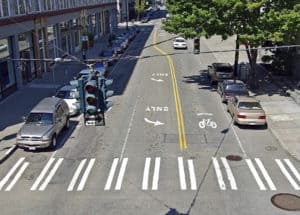A 2013 study released by Oregon State University reveals that about 4 – 9% of the time, drivers making a “permitted” left turn do not look to see whether there are any pedestrians in their path of travel. [1] (A “permitted” left turn is defined as one in which a left turn is allowed by a circular green light, a flashing circular yellow light, a flashing circular red light, or a flashing yellow arrow, as opposed to a “protected” left turn in which in which a solid green arrow gives a driver the complete right of way in a left-turn lane).
 This estimate is much higher than previously thought. The engineers conducting the research found that approximately one time in 10 or 20, a driver attempting a left turn did not even look to see whether there was a pedestrian ahead before initiating the turn. As part of the study, the researchers used a full-scale driving simulator that monitored eye movements. The heavier the traffic, the less attention research subjects paid to the possible presence of pedestrians. In essence, the study found that many drivers were simply faced with too many distractions while attempting a left turn on a traffic signal other than a basic left green turn arrow. These distractions ranged from focusing on narrow windows in which to complete a turn relative to oncoming traffic, to focusing on the traffic signal rather than the intended path of the vehicle.
This estimate is much higher than previously thought. The engineers conducting the research found that approximately one time in 10 or 20, a driver attempting a left turn did not even look to see whether there was a pedestrian ahead before initiating the turn. As part of the study, the researchers used a full-scale driving simulator that monitored eye movements. The heavier the traffic, the less attention research subjects paid to the possible presence of pedestrians. In essence, the study found that many drivers were simply faced with too many distractions while attempting a left turn on a traffic signal other than a basic left green turn arrow. These distractions ranged from focusing on narrow windows in which to complete a turn relative to oncoming traffic, to focusing on the traffic signal rather than the intended path of the vehicle.
Interestingly, the researchers concluded that permitted left turns are now sufficiently dangerous to pedestrians that states should consider prohibiting them. In fact, in Washington County, Oregon, traffic managers recently implemented this step after a high numbers of pedestrian-vehicle collisions.
Also of interest is the preliminary evidence to suggest that the currently-mandated type of signal in many states, which uses four heads instead of three, can still be sufficiently dangerous as to cause an immediate hazard to pedestrians in a crosswalk. However, the cost to implement a four-head signal is about $800 more than retrofitting the three-head version, which is widely used around the nation, prompting the question of whether many millions of dollars might be saved nationally by using the simpler signal.
As the amount of foot traffic increases in cities around Washington State, it is crucial for both drivers and pedestrians to take the utmost care in these situations to avoid the potential for serious personal injuries.
[1] Oregon State University (2013, April 2). Pedestrians at serious risk when drivers are ‘permitted’ to turn left. ScienceDaily. Retrieved
